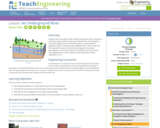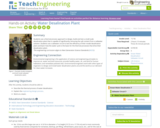
ZOOM cast members use a homemade solar still to mimic the water cycle, separating pure water from a saltwater mixture. [3:34]
- Subject:
- Science
- Material Type:
- Audio/Video
- Provider:
- PBS LearningMedia
- Date Added:
- 12/01/2022

ZOOM cast members use a homemade solar still to mimic the water cycle, separating pure water from a saltwater mixture. [3:34]

Groundwater is one of the largest sources of drinking water, so environmental engineers need to understand groundwater flow in order to tap into this important resource. Environmental engineers also study groundwater to predict where pollution from the surface may end up. In this lesson, students will learn how water flows through the ground, what an aquifer is and what soil properties are used to predict groundwater flow.

Animation and text explain the water--or hydrologic--cycle, which is the process that water undergoes in nature.

Water is the source of life on earth. It exists in many forms and is constantly changing. The circulation and conservation of earth's water is called the hydrologic (or water) cycle. Find out how water evaporates, condensates, precipitates, transpires, and is transported around the earth.

This animation from NASA visualizes the steps of the water cycle, including precipitation, evaporation, transpiration, and condensation. [0:52]

Students use a thermal process approach to design, build and test a small-scale desalination plant that is capable of significantly removing the salt content from a saltwater solution. Students use a saltwater circuit to test the efficiency of their model desalination plant and learn how the water cycle is the basis for the thermal processes that drive their desalination plant.

Learn about the four phases of the water cycle, the ways in which watersheds are crucial to healthy water, and the best ways to manage local watersheds with this interactive lesson.

Students learn about the Earth's water cycle, especially about evaporation. Once a dam is constructed, its reservoir becomes a part of the region's natural hydrologic cycle by receiving precipitation, storing runoff water and evaporating water. Although almost impossible to see, and not as familiar to most people as precipitation, evaporation plays a critical role in the hydrologic cycle, and is especially of interest to engineers designing new dams and reservoirs, such as those that Splash Engineering is designing for Thirsty County.

Learn about the different stages of the Earth's water cycle, and about processes involving water, including runoff, infiltration, and the differences between hard and soft water.